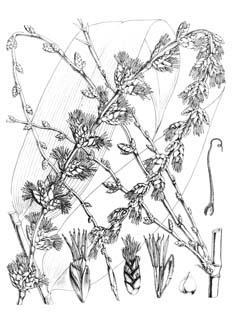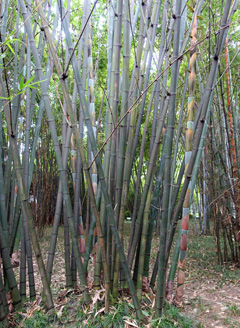 |
|
https://edibleplants.org/ |
 |
| https://edibleplants.org/ |
Translate this page:
Summary
Dendrocalamus latiflorus or commonly known as Sweet Bamboo is found in East Asia specifically in southern China, Myanmar, and Vietnam. It is densely tufted, sympodial, and evergreen. Its culm is erect with a pendulous tip and reaches a height of up to 25 m and diameter of up to 20 cm. Young shoots are edible either raw or cooked. Mature culms are used as water pipes or made into small rafts, baskets, paper pulp, and for house construction. D. latiflorus is sometimes used as an ornamental plant. Plants can be grown from seed or by rhizome and culm cuttings.
Physical Characteristics

 Dendrocalamus latiflorus is an evergreen Bamboo growing to 20 m (65ft) by 10 m (32ft) at a fast rate.
Dendrocalamus latiflorus is an evergreen Bamboo growing to 20 m (65ft) by 10 m (32ft) at a fast rate.
See above for USDA hardiness. It is hardy to UK zone 10. The flowers are pollinated by Wind.
Suitable for: light (sandy), medium (loamy) and heavy (clay) soils and prefers well-drained soil. Suitable pH: mildly acid, neutral and basic (mildly alkaline) soils. It cannot grow in the shade. It prefers moist soil.
UK Hardiness Map
US Hardiness Map
Synonyms
Bambusa latiflora (Munro.) Kurz Sinocalamus latiflorus (Munro.) McClure.
Plant Habitats
Edible Uses
Edible Parts: Shoots Stem
Edible Uses:
Young stems - raw or cooked[ 301 ]. Unusually free of any unpleasant taste, even when raw[ 301 ]. Considered to be delicious[ 310 ]. They are also shredded and dried then used in Chinese-style snacks in Japan[ 301 ]. The stems can be 15 - 30cm in diameter[ 266 ]. Young shoots are harvested 7 - 25 days after emergence, when they are 35 - 60 cm tall. Harvesting may start in the 2nd year of growth of a clump[ 310 ]. Harvested shoots are steamed, cut lengthwise, cleaned and sterilized for 15 minutes in pure or salted boiling water before eating or canning[ 310 ]. When boiled in pure water a white compound (containing 90% tyrosine) usually precipitates, which can be removed by boiling for 1.5 hours in a 0.06 - 0.07% citric acid solution, followed by 12 hours of washing. For the production of fermented dry shoots, the middle parts of shoots are boiled first and then left to ferment for 2 - 4 weeks, and subsequently sliced into parts of 4 - 5 cm x 2.8 mm[ 310 ]. In the Philippines harvested culms are either dried directly in the sun or shade or first kept in running water for several weeks before being air dried[ 310 ].
References More on Edible Uses
Medicinal Uses
Plants For A Future can not take any responsibility for any adverse effects from the use of plants. Always seek advice from a professional before using a plant medicinally.
None known
References More on Medicinal Uses
The Bookshop: Edible Plant Books
Our Latest books on Perennial Plants For Food Forests and Permaculture Gardens in paperback or digital formats.

Edible Tropical Plants
Food Forest Plants for Hotter Conditions: 250+ Plants For Tropical Food Forests & Permaculture Gardens.
More

Edible Temperate Plants
Plants for Your Food Forest: 500 Plants for Temperate Food Forests & Permaculture Gardens.
More

More Books
PFAF have eight books available in paperback and digital formats. Browse the shop for more information.
Shop Now
Other Uses
Basketry Biomass Fibre Fibre Packing Paper Pipes Wood
Other Uses: The leaves are used to make hats, roofs for boats and as material for packing[ 310 ]. The culm is erect with a pendulous tip, growing 14 - 25 metres tall, 8 - 20 cm in diameter at the base, with a wall 5 - 30mm thick and internodes that are 20 - 70 cm long[ 310 ]. Mature culms are used as water pipes, to make small rafts for fishing in streams, to weave baskets, and are also used in house construction and for making paper pulp[ 310 ]. Harvesting of culms may start when clumps are 3 - 7 years old. To ensure sustainable yields, only over-mature and a few mature culms should be harvested at one time, and the number of harvested culms should not exceed 60% of the standing mature culms[310.
Special Uses
Carbon Farming Food Forest
References More on Other Uses
Cultivation details
Industrial Crop: Biomass Management: Managed Multistem Minor Global Crop Other Systems: Multistrata Other Systems: Strip intercrop
Succeeds in subtropical conditions, as well as in lowland to moderate elevations in the tropics[ 310 ]. It is found at elevations up to 1,000 metres in Taiwan, where it can tolerate temperatures as low as -4°c[ 310 ]. It prefers areas of high rainfall[ 310 ]. Grows best in moist, fertile soils[ 310 ]. Heavy clay, gravel alkaline or acidic soils are not suitable for the production of edible shoots[ 310 ]. Vegetatively propagated plants can develop within 3 years into clumps with 20 - 25 culms, on average 5 - 6 metres tall and 3 - 4cm in diameter[ 310 ]. Five year old plants can have a culm height in the region of 15 metres with a diameter of 7cm[ 310 ]. A 1 - 2 year-old culm can produce 5 - 10 shoots weighing 3 - 5 kg[ 310 ]. Average young shoot production per clump increases in the first 5 years after planting from 30 kg in the 2nd year to 60 kg in the 3rd year to 80 kg in the 4th year, to a maximum of about 100 kg in the 5th year[ 310 ]. Bamboos have an interesting method of growth. Each plant produces a number of new stems annually - these stems grow to their maximum height in their first year of growth, subsequent growth in the stem being limited to the production of new side branches and leaves. In the case of some mature tropical species the new stem could be as much as 30 metres tall, with daily increases in height of 30cm or more during their peak growth time. This makes them some of the fastest-growing species in the world[ K ]. The plant is used in breeding programmes to develop hybrid cultivars that grow fast and provide quality construction material with wide adaptability and high economic value, or to provide better tasting shoots[ 310 ]. Bamboos in general are usually monocarpic, living for many years before flowering, then flowering and seeding profusely for a period of 1 - 3 years before usually dying. Flowering is rare in Taiwan; though sporadic flowering and fruiting is a normal occurrence in the Philippines, Indonesia and China[ 310 ].
Carbon Farming
-
Industrial Crop: Biomass
Three broad categories: bamboos, resprouting woody plants, and giant grasses. uses include: protein, materials (paper, building materials, fibers, biochar etc.), chemicals (biobased chemicals), energy - biofuels
-
Management: Managed Multistem
Regularly removing some multiple stems. A non-A non-destructive management systems maintaining the soil organic carbon.
-
Minor Global Crop
These crops are already grown or traded around the world, but on a smaller scale than the global perennial staple and industrial crops, The annual value of a minor global crop is under $1 billion US. Examples include shea, carob, Brazil nuts and fibers such as ramie and sisal.
-
Other Systems: Multistrata
Multistrata agroforests feature multiple layers of trees often with herbaceous perennials, annual crops, and livestock.
-
Other Systems: Strip intercrop
Tree crops grown in rows with alternating annual crops.
References Carbon Farming Information and Carbon Sequestration Information
Temperature Converter
Type a value in the Celsius field to convert the value to Fahrenheit:
Fahrenheit:
The PFAF Bookshop
Plants For A Future have a number of books available in paperback and digital form. Book titles include Edible Plants, Edible Perennials, Edible Trees,Edible Shrubs, Woodland Gardening, and Temperate Food Forest Plants. Our new book is Food Forest Plants For Hotter Conditions (Tropical and Sub-Tropical).
Shop Now
Plant Propagation
Seed - sow in containers and only just cover. Germination usually takes place readily - usually about 90% germination within 2 weeks[ 310 ]. Prick out into individual pots as soon as the plants are large enough to handle. Plant out into permanent positions when 20cm tall. Plants may remain in their low-growing juvenile state for several years - cutting the culms to the ground level can stimulate taller adult growth[ 200 ]. The seed rapidly loses its viability[ 310 ]. As seed is usually rather rare, vegetative propagation by cuttings is normal practice. The preferred cuttings are taken from 2-year-old culms, are 50 cm long (2-noded), and are planted horizontally 6 - 10 cm deep. The rooted cuttings are preferably transplanted in the rainy season when 2 years old[ 310 ].
Other Names
If available other names are mentioned here
Ma bamboo, Big jute bamboo, Machiku, Ma-chu,
Native Range
TEMPERATE ASIA: Fujian Sheng, Guangdong Sheng, Guangxi Zhuangzu Zizhiqu, Guizhou Sheng, Hainan Sheng, Sichuan Sheng, Taiwan, Yunnan Sheng,China. TROPICAL ASIA: Myanmar, Vietnam,
Weed Potential
Right plant wrong place. We are currently updating this section.
Please note that a plant may be invasive in one area but may not in your area so it's worth checking.
Conservation Status
IUCN Red List of Threatened Plants Status : This taxon has not yet been assessed .

Growth: S = slow M = medium F = fast. Soil: L = light (sandy) M = medium H = heavy (clay). pH: A = acid N = neutral B = basic (alkaline). Shade: F = full shade S = semi-shade N = no shade. Moisture: D = dry M = Moist We = wet Wa = water.
Now available:
Food Forest Plants for Mediterranean Conditions
350+ Perennial Plants For Mediterranean and Drier Food Forests and Permaculture Gardens.
[Paperback and eBook]
This is the third in Plants For A Future's series of plant guides for food forests tailored to
specific climate zones. Following volumes on temperate and tropical ecosystems, this book focuses
on species suited to Mediterranean conditions—regions with hot, dry summers and cool, wet winters,
often facing the added challenge of climate change.
Read More
Expert comment
Author
Munro.
Botanical References
Links / References
For a list of references used on this page please go here
A special thanks to Ken Fern for some of the information used on this page.
Readers comment
| Add a comment |
|
If you have important information about this plant that may help other users please add a comment or link below. Only comments or links that are felt to be directly relevant to a plant will be included. If you think a comment/link or information contained on this page is inaccurate or misleading we would welcome your feedback at [email protected]. If you have questions about a plant please use the Forum on this website as we do not have the resources to answer questions ourselves.
* Please note: the comments by website users are not necessarily those held by PFAF and may give misleading or inaccurate information.
To leave a comment please Register or login here All comments need to be approved so will not appear immediately.
|
Subject : Dendrocalamus latiflorus
|
|
|
|